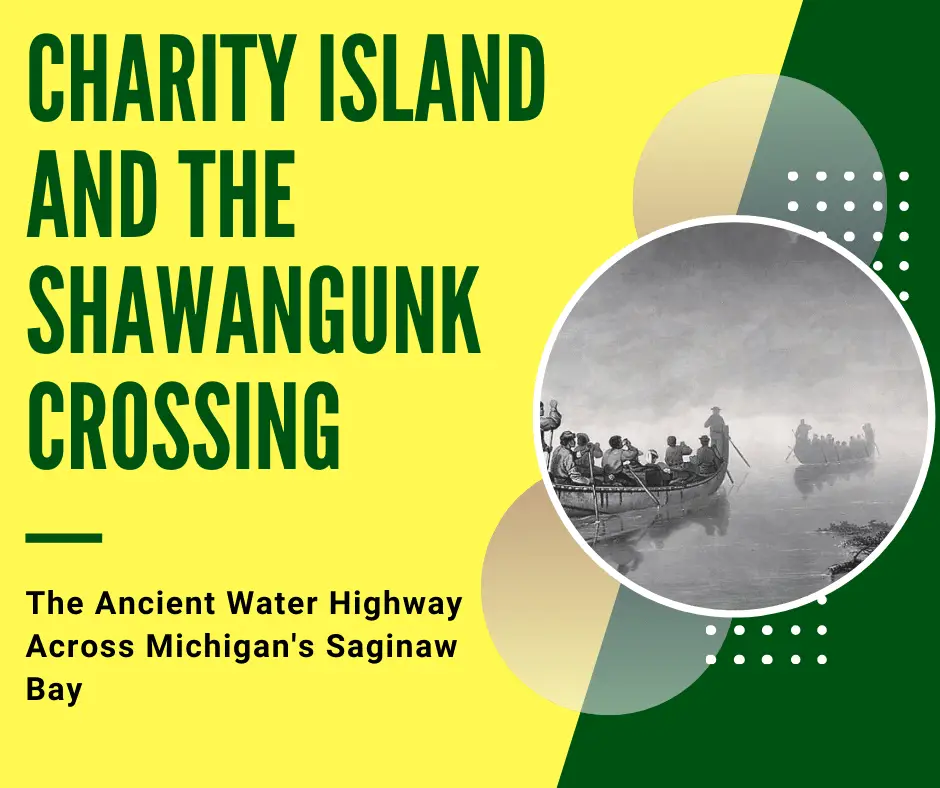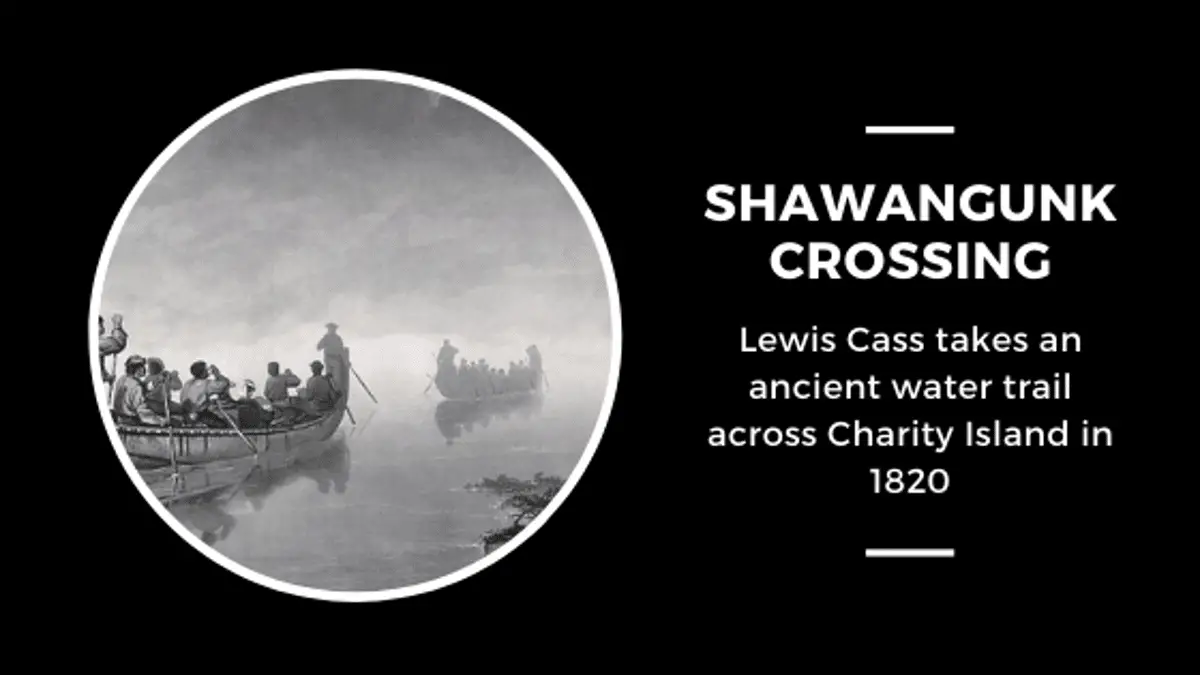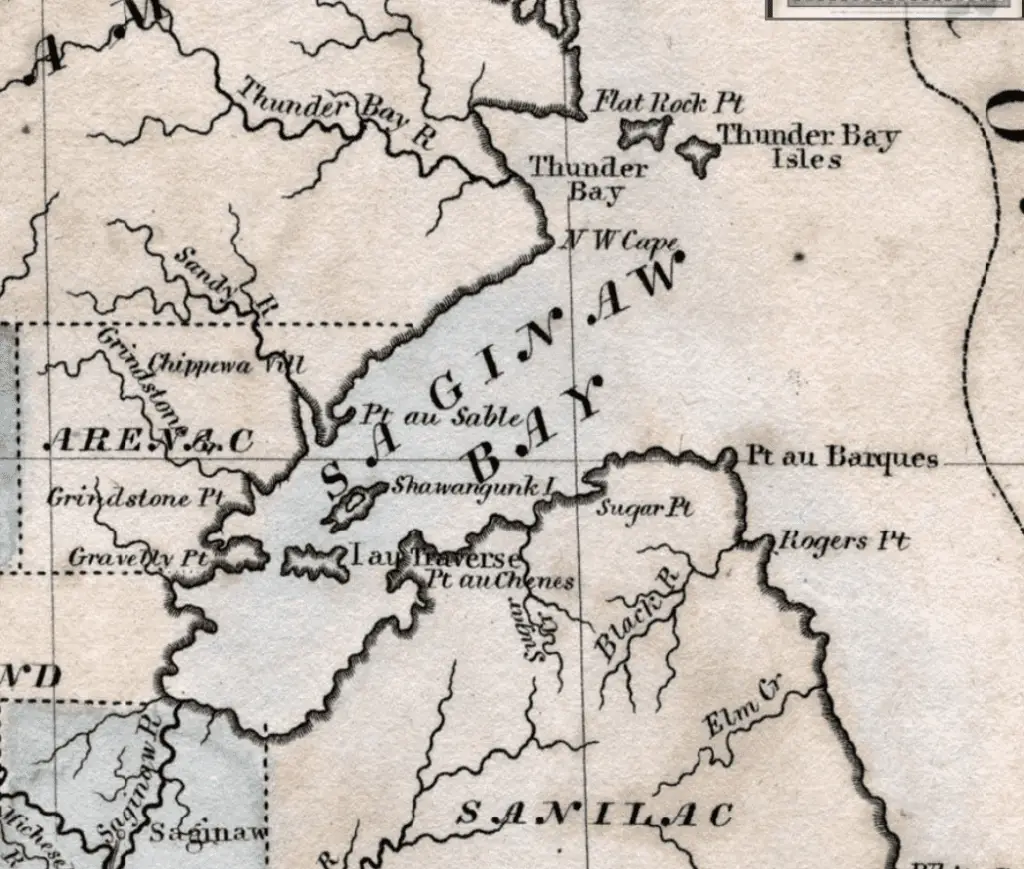
1820 Exploration of Saginaw Bay Michigan
I learned about Henry Schoolcraft while still in grade school. I don’t remember the details, but there may have been a children’s story involved. I found it hard to imagine that Michigan could be so wild and untouched.
Henry Schoolcraft lived from 1793 until 1864. He was an explorer, Indian agent, and early ethnologist of Native American culture. While a scientist, he had some fantastic real-life adventures that would have put Indiana Jones to shame.
Henry Schoolcraft was asked to join an expedition organized by Governor Cass of Michigan in 1819. Its purpose was to locate the source of the Mississippi River and explore the Great Lakes region. As an expert mineralogist, he was tasked with describing Michigan’s significant topographical features, natural history, and mineral wealth. The expedition took approximately 40 men in five long voyageur canoes commonly used in the fur trade on the Great Lakes. At 35 feet long and 6 feet wide, the canoe had an amazing capacity of four tons. They started the journey on May 24, 1820.
The route that the expedition noted and took to cross Saginaw Bay supports a theory that the path of Oak Point-Charity Island-AuSable was part of an ancient Indian transit route that included the Indian Trail that starts in Saginaw and ends in Port Austin. See Indian Trails of Michigan.
This is a small excerpt from his journal as he describes, sometimes in excruciating detail, the canoe travel on the lakes. This set of excerpts takes place between Pointe Aux Barques at the tip of Michigan’s Thumb to an area today known as Tawas via Charity Island. The expedition continues to Michilimackinac and presses on to Sault de Ste. Marie and Fond du Lac and into Wisconsin. The content has been reduced to the highlights of Saginaw Bay and Charity Island in 1820. It also contains terms and a language tone that some may find offensive.
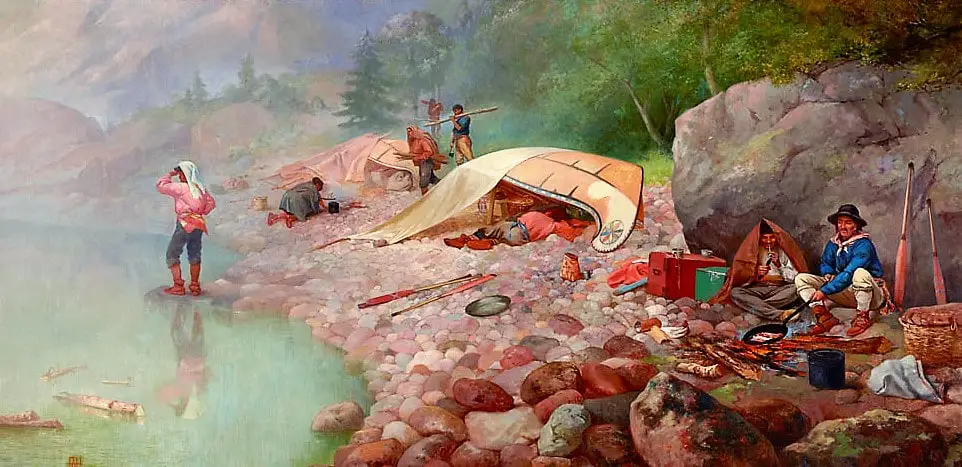
Day 10 – June 2nd, 1820 – Pointe Aux Barques – Upbound
In order to cross Saganaw Bay with safety in a canoe, it is necessary to pass up the eastern shore from Point aux Barques to Point aux Chenes, a distance of eighteen miles. Here, if the lake be calm, the voyageur crosses by a stretch of twenty miles to the opposite shore, with the advantage of landing on the island of Shawangunk, should a storm overtake him in the centre of the Bay, which is frequently the case. On gaining the opposite shore, it is necessary to pass down the bay about the same distance that was formerly ascended, before the open lake is again reached.
The entire crossing can easily be performed in one day if the weather is favourable, but this does not always happen, and the fatal accidents that have formerly befallen those who were too venturesome, have operated as a severe caution to voyageurs and canoe travellers of the present day so that it is difficult to induce the former to attempt it, unless the weather be perfectly clear and the bay calm. Fortunately, we were not detained by these causes, and effected the crossing and re-entry of the lake at so seasonable on hour, that we were allowed time to proceed two leagues beyond, and encamped at the mouth of the river aux Sablés, making an entire distance of fifty-six miles.
In crossing the bay we landed a few moments upon shawangunk island which is found to be based upon compact limestone, and contains imbedded masses of Chalcedony, and calcareous spar. I also picked up, during the short period we remained, a lump of the argillaceous oxyd of iron, and some detached fragments of a coarse striped jasper. These discoveries created a strong desire to make a geological survey of the island, but we were prevented from attempting it, by the necessity of an expeditious progress across the bay while the weather favoured.
On reaching the river aux Sablés, we found a number of Chippeway Indians upon the shore, and a permanent village at the distance of two miles above its discharge. They appeared friendly, and as soon as our tents were pitched came formally to the Governor’s marque. A chief of the Chippeways then addressed the Governor in a speech in which he told him that he was glad to see him there—that he had heard of his coming—and hoped he would see, and relieve their wants, &c. The pipe of peace was then smoked in the usual style of Indian ceremony, by handling it to all present, each one taking a whiff, which is all that is required: when this ceremony was ended, they commenced that of shaking hands.
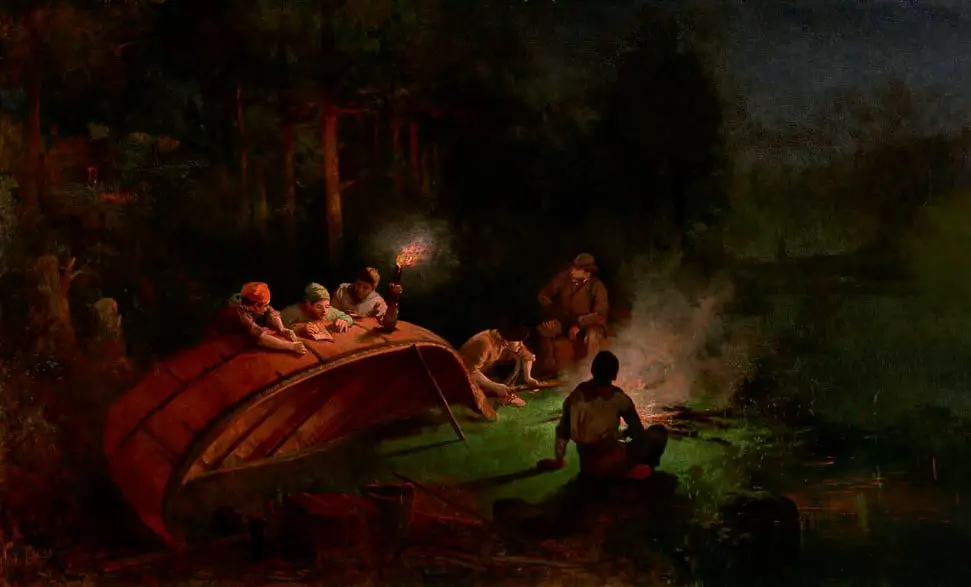
Day 117 – September 17th, 1820 – Downbound
We proceeded across Thunder Bay, at five o’clock in the morning, landing a few moments upon the island near its centre, and passing successively, the spot of our former encampment, at the mouth of the river aux Sables, and the northwest cape of Saganaw Bay, encamped on the western shore of the latter, at Sandy Point; having made a journey of fifty-five miles. Here we found a family of Saganaw Indians, who had taken up a temporary residence at that place, attracted by the abundance of water fowl, found in a contiguous inlet.
These people lead a wandering life, abiding but a short time at a place, changing their habitations whenever the deer, the fish, or the wild fowl, promise an easier subsistence at another place. They live in tents formed of rush-mats, supported by a few slender poles; and all their moveable effects and household goods, together with the family, are readily transported in a birch bark canoe.
On entering the tent, we found no person in, but the squaw and children, who manifested none of that timidity, and apparent fear, which it is common to find among unfrequented tribes. The woman was engaged at the moment, in picking the feathers from a number of wild ducks, apparently just killed, which lay at her side, and our entrance appeared to have no more effect upon her than it probably would, had one of her own family entered. She continued her work, This may be considered as the result of the confidence they repose in the whites,—the frequency of their interviews with traders and travelers, and the uniform justice which they have received from our citizens and our government.
We observed a number of smoked squirrels, fish, and ducks, hanging in the upper part of the tent; indicating a degree of care, for the subsistence of their children, and forecast as to the uncertainties of the chase, which is highly honorable to the judgment and the paternal feelings of these people.
They have a method of taking fish through the ice in the winter season, which is equally novel and ingenious. After a hole has been cut through the ice, they encompass it with a slender circular frame of rods, or a kind of open basket, over which a blanket, is thrown to exclude the light. The savage now lays himself down upon the ice, with his head under this hood, and playing a decoy or artificial fish upon the surface of the water within the hand, holds a drawn spear in the other, and when the large trout suddenly dart up to seize their fancied prey, pierces the body of his victim with unerring certainty. The spear is short and loosens itself from the handle the moment it is struck, but is attached to a strong line, with which he plays the fish a while in the water below, and draws it out as soon as it becomes sufficiently enfeebled with the wound. This method of fishing was first noticed by Mr. Hudson, a missionary among the Saganaws, to whose manuscript journal I am permitted to refer for the facts.
Day 118 – September 18th, 1820 – Downbound Comments by Henry Schoolcraft
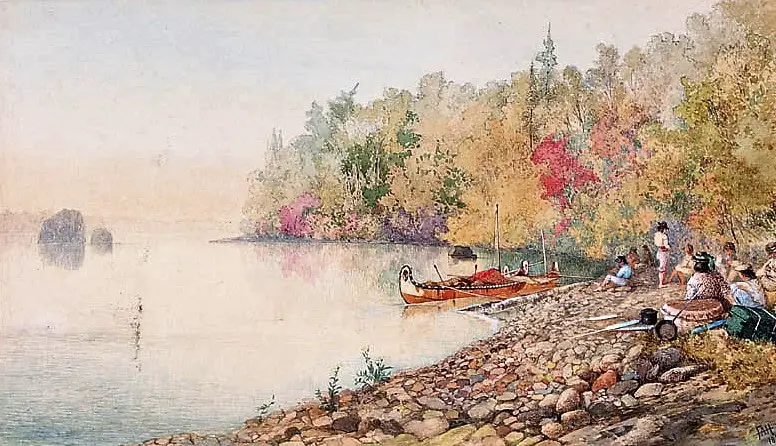
Crossed Saganaw Bay, stopping an hour upon the island of Shawangunk, and encamped in the eastern cove of Point aux Barques; —distance forty-two miles. The island of Shawangunk is an alluvial plain of four or five miles in circumference, based upon a calcareous rock which is compact, stratified, without organic remains, and containing very large embedded masses of chalcedony, and calcareous spar. These, have been broken out by the violence of the waves around the margin of the island, and lie promiscuously among the fragments of limestone torn up by the storms, and among large boulders of granite, hornblende, trap, greenstone porphyry, quartz, argillite, and sienite. The island is covered with a beautiful growth of oak, and its numerous little bays and inlets appear to be a favorite resort of aquatic birds.
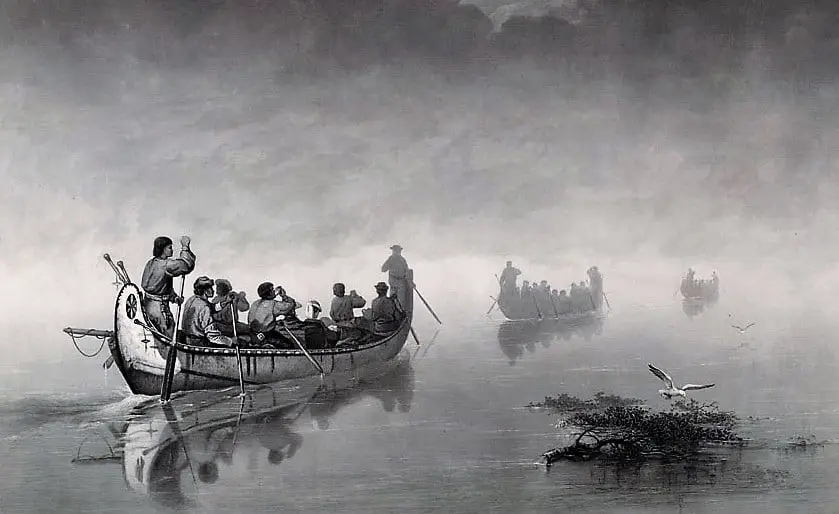
Day 119 – September 19th, 1820 – Downbound by Henry Schoolcraft
Detained at Point aux Barques, by head winds.
An opinion is prevalent among the inhabitants of the region, that the northwestern lakes are gradually running out, or in other words, that the level of the waters is constantly lowering: some suppose this diminution to take place periodically, others, by constant and imperceptible exhaustion.
I have been informed by an intelligent person at Michilimackinac, who has been in the habit of making observations upon the rocks which project above the water, that the level of Lake Huron has fallen afoot within the last eight years. It has also been advanced, that his decrease continues for a definite period of years, as seven, or fourteen, and that at the expiration of a like period, after sinking to its minimum level, it attains its former height in the same gradual and imperceptible manner, and that thus a ceaseless ebbing and flowing of the lakes, is produced.
A moment’s reflection, however, will render it manifest that in a country so extensive and thinly populated, a number of circumstances may operate to produce a deception with respect to the permanent diminution of water, as the prevalence of certain winds, the quantity of rain and snow that falls around their shores, &c. There can be a doubt that the extra quantum of water discharged during the spring and fall, by the numerous streams and rivers flowing into these lakes, produces a corresoinding rise in the lakes themselves, which suffer a gradual diminution as midsummer approaches.
It is also obvious, that the evaporation of water, must vary greatly during the different seasons, in our fluctuating climate; and produce a sensible departure from the standard levels of the different lakes. Conclusion, therefore, drawn from the appearances of any particular point along this great chain, should be received with great caution; and they must always be exposed to an error in the precise ratio that the temperature of the air, the quantity of rain which has fallen, and the prevalent winds, during the times which shall be selected for the experiment, shall have been correctly registered and compared.
Place Names Today
- River aux Sables = AuSable River
- Island of Shawangunk = Charity Island
- Point aux Chenes = Oak Point
- Point aux Barques = Pointe aux Barques
Sources
- Michigan. Drawn & published by David H. Burr in New York in 1831. Michigan State University
- Narrative journal of travels through the northwestern regions of the United States: extending from Detroit through the great chain of American lakes to the sources of the Mississippi River, performed as a member of the expedition under Governor Cass. In the year 1820. Library of Congress.
Related Reading
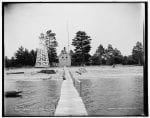
The History of Pointe Aux Barques – Point of Boats – The name Pointe Aux Barques was coined by French sailors and voyeurs in about 1760. The name literally means the point of boats, This is because the rock formations found in the area looked like the prow of a ship. This area was also known as a hideout for sailors in the caves of the area.
Top 12 Michigan Thumb Attractions – With over 90 miles of shoreline, Michigan’s Thumb offers plenty of attractions. There is always something to do or see near the tip of the Thumb. Most are free, the fun is finding and exploring things to do in Michigan’s Upper Thumb. How many have you been to?
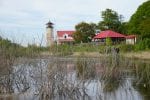
Charity Island Michigan Lighthouse Ruins 1993 – In 1997 plans for the development of Charity Island were deferred and the developer sold most of the island to the U.S. Fish and Wildlife Service as a new acquisition for Michigan Islands National Wildlife Sanctuary.
Charity Island Dinner Cruise – What I Learned, a Review – As the clock ticked close to 4 pm, Captain Tom welcomed all aboard. He gave safety instructions about the boat and how to use life jackets. Next, he then gave a few details of what to expect during the trip. Finally, the captain and crew cast us off the dock and we were rumbling out of the harbor waving to folks along Caseville’s break wall.
